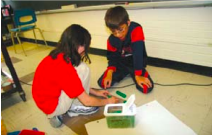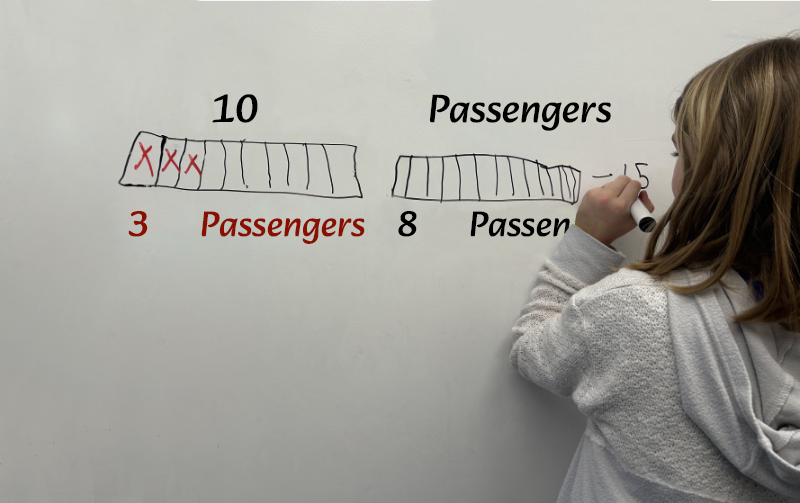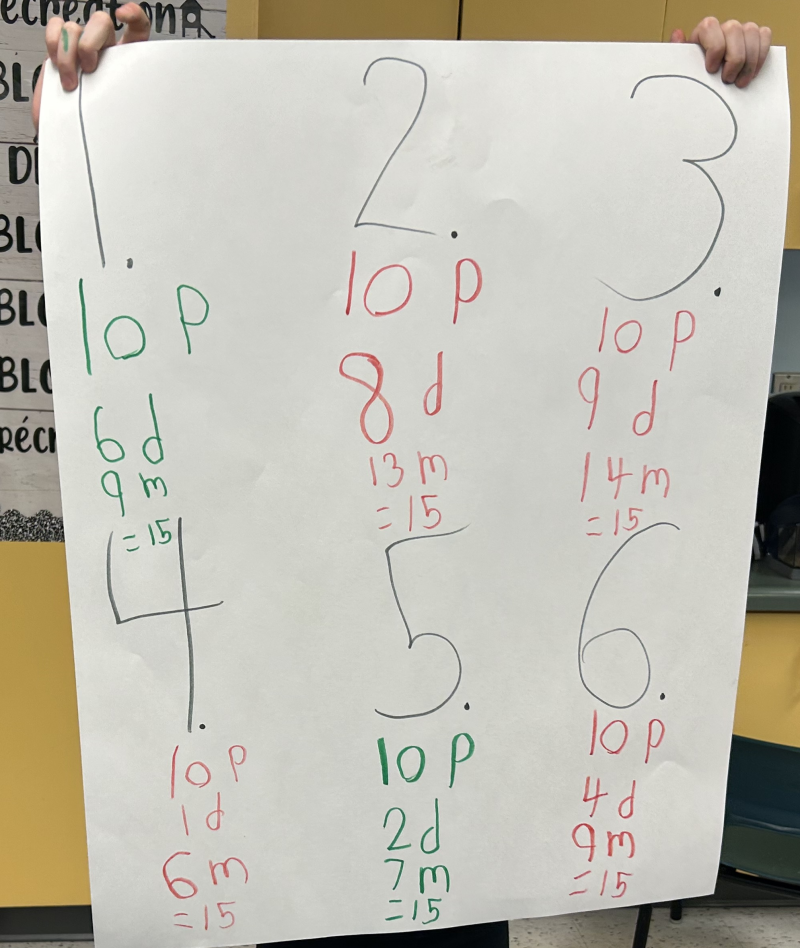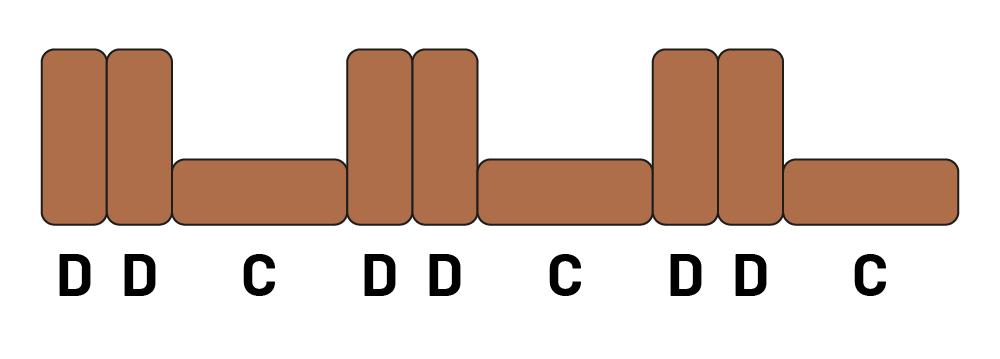C2.1 Identify when symbols are being used as variables, and describe how they are being used.
Skill: Using Variables Appropriately and Describing Them
Symbols in Everyday Life
At a very young age, children evolve in a world where symbols are used to communicate a message or define a function.
Examples
- traffic lights dictate behaviour (red means stop or no go; green means go);
- the characters on the doors of the washrooms give information as to the purpose of the room;
- in the daycare centre, several symbols indicate where to store toys, clothes, etc;
- a song or rhyme announces a specific activity (for example, snack time, rest time, tidying up);
- WHMIS safety signs make children aware of the toxicity of cleaning products;
- road signs, logos, and commercial signs quickly become meaningful to children.
The acquisition of these symbols is experiential, without the symbols being systematically taught, memorized, or recited. Despite their arbitrary nature, the symbols quickly become familiar to children. Thus, each symbol used in a given context is associated with a specific meaning. However, they may be subject to other interpretations if used in new contexts.
Symbols in Mathematics
Mathematical symbols represent fundamental concepts that underlie the learning of mathematics and algebra. Many of these concepts, which have become familiar to adults, are often introduced to students prematurely in out-of-context situations or without prior explanation. In order to explain them clearly and accurately, it is therefore essential to create situations in which students have time to become familiar with the symbols and to appropriate their meaning.
| Symbols in Mathematics | Examples |
|---|---|
| Symbols Designating Quantities - Numbers (Indo-Arabic Numerical or Graphic Symbols) |
0, 1, 2, 3, 4, 5, 6, 7, 8, 9 |
| Symbols Representing Fundamental Operations - Signs that designate the four operations in numeration |
– + × ÷ |
| Symbols that Establish Relationships The sign that indicates equality Signs that indicate inequality |
= ≠ > < |
Source: translated from Guide d’enseignement efficace des mathématiques de la maternelle à la 3e année, Modélisation et algèbre, Fascicule 2, Situations d'égalité, p. 52.
Meaning of Symbol in Algebra
Luis Radford (2001) sees learning algebra as the appropriation of a new mathematical way of thinking and acting that involves the production and use of symbols. These symbols carry meaning for students as they are explored in contextualized mathematical activities.
A key component of algebraic reasoning is the ability to recognize and explore relationships that link various quantities. These relationships are represented by various symbols that students must learn to use appropriately.
In the primary grades, a dash, geometric shape, or other symbol in an equation represents an unknown quantity. For example, in the equation 3 + Δ = 5, the triangle is a symbol that represents a quantity when added to 3 has a result of 5. In this case the triangle is 2.
Students with a fair understanding of this will be able to more effectively interpret or manipulate the literal symbols commonly used in algebra to represent the unknown or variable in the junior grades. Symbol meaning plays an important role in the development of algebraic thinking. Understanding of symbols is a function of students' maturity and diversity of experience.
Here are some points to consider to help students develop a sense of the symbol:
- Introduce students to symbols in challenging and realistic contexts to enable them to grasp their meaning and, ultimately, to understand the concepts behind them.
- Encourage students to identify the elements to be represented in a problem situation, to choose an appropriate mode of representation, and to use personal symbols.

Above, students use the first letter of each animal's name to formulate the number sentence; for example, C represents the cat, G represents the goat, and R represents the rabbit.
Encourage students to determine when and how to use symbols (for example, represent a missing quantity, in an equation, with a square).
Provide activities that require students to make connections between various modes of representation, discuss these connections, and justify them using mathematical arguments.
To understand the meaning of the symbol, students should:
- describe relationships using various modes of representation before exploring them symbolically;
- make connections between representations.
Source: translated from Guide d’enseignement efficace des mathématiques de la maternelle à la 3e année, Modélisation et algèbre, Fascicule 2, Situations d'égalité, p. 51-54.
It is also important to have students observe that there are quantities that do not change in their daily lives. Quantities that remain the same are also referred to as “constants”. Identifying quantities in real life that stay the same and those that can change will help students understand the concept of variability.
Source: Ontario Curriculum, Mathematics Curriculum, Grades 1-8, 2020, Ontario Ministry of Education.
The effective use of different modes of representation, including the use of symbols, not only exists within the algebra strand but should be nurtured throughout all of the strands. For example, students use symbols when working with measurement formulas.
Here is an example of an authentic problem situation illustrating a progressive path towards developing an understanding of the meaning of the symbol.
| Pathway to Develop an Undestanding of the Meaning of the Symbol | Examples |
|---|---|
| Present the situation and the data. | A student could state the following: "There are 10 people on the bus after the first stop and 15 people after the second stop. How many people got on the bus at the 2nd stop? got off?" |
| Propose a conjecture. | I believe that the number of people getting off the bus is always smaller than the number of people getting on the bus. |
| Represent the problem situation using concrete materials or drawings. | Students use cubes to represent people.

Students represent the people with drawings. 
|
| Gradually move away from visual (semi-concrete) representations and use personal symbols to communicate understanding of the situation. | In the picture below, the student has chosen the following symbols as labels:
p for people; d for people getting off the bus; m for people boarding the bus. 
|
To develop a sense of the unknown, students need to explore a variety of authentic situations that engage meaningful data and promote the transition from the concrete to the abstract.
Source: translated from Guide d’enseignement efficace des mathématiques de la maternelle à la 3e année, Modélisation et algèbre, Fascicule 2, Situations d'égalité, p. 54-55.
Symbols can be used to represent and describe, in an abstract way, the pattern created in a concrete or visual (semi-concrete) representation.
For example, students use a visual (semi-concrete) representation to illustrate a pattern of bricks placed vertically and horizontally.
Example 1

Students quickly realize that it takes a long time to draw the bricks and then decide, as a result of this realization, to use symbols such as D (standing) and C (lying) to represent the standing brick and lying brick elements in the suite and describe its structure.
By using symbols that are meaningful to them, students deepen their understanding of a symbolic representation. The symbols then become an efficient way to represent the situation and the observed pattern.
Example 2

Source: translated from Guide d’enseignement efficace des mathématiques de la maternelle à la 3e année, Modélisation et algèbre, Fascicule 1, Régularités et relations, p. 17.
Knowledge: Symbol
Graphic sign that represents a number, an operation, a relationship.
Note: In an equation, if the same symbol appears more than once, its value is the same, For example,  . Two different symbols in an equation can have varying values. For example,
. Two different symbols in an equation can have varying values. For example,  , the two symbols can have values of 10 and 10, 19 and 1, etc.
, the two symbols can have values of 10 and 10, 19 and 1, etc.
Knowledge: Variable
A term (symbol or letter), in an equation, that can be replaced by one or more values.
In the equation  Or 10 = x + y, the shapes or letters are variables, because the quantities are unknown.
Or 10 = x + y, the shapes or letters are variables, because the quantities are unknown.
Source: translated from En avant, les maths!, 2e, CM, Algèbre, p. 2.
Knowledge: Constant
The quantities that remain the same are called constants.
Example
Looking at the pattern below, we notice that in each term/shape, what stays the same, the constant, is the group of 8 purple squares. What changes are the groups of red squares.

Source: translated from En avant, les maths!, 2e, CM, Algèbre, p. 2.
